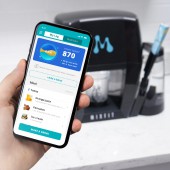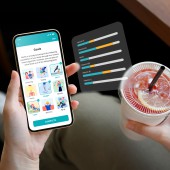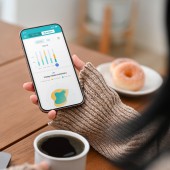Mina Health App by Chunxuan Yu |
Home > |
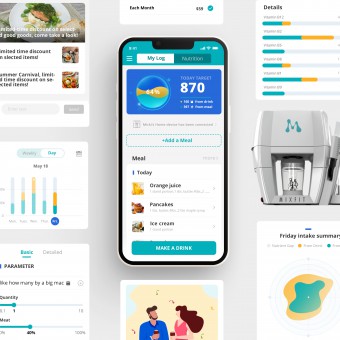 |
|
||||
| DESIGN DETAILS | |||||
| DESIGN NAME: Mina PRIMARY FUNCTION: Health App INSPIRATION: Amidst the Covid crisis, people realized there was no one-size-fits-all solution in diet or supplements. People began reevaluating their lifestyles for better personal health. How could a system track this data and therefore provide delicious drink nutrients one's body needs in a given moment.. UNIQUE PROPERTIES / PROJECT DESCRIPTION: MixFit provides customers with an app called Mina, in conjunction with a beverage-making machine. These two components collaborate to monitor the customer's activity, dietary habits, blood levels, and other factors. They then create beverages containing precisely the right amount of nutrients that the app(Mina) forecasts the customer's body needs at that specific moment. OPERATION / FLOW / INTERACTION: **1. Setting Up Your Profile:** - As a user, I start by creating my profile within the Mina app. I provide basic information like my age, gender, and dietary preferences. **2. Data Integration and Collection:** - The app seamlessly connects with my wearable fitness devices and apps, automatically collecting data on my physical activities, sleep patterns, and heart rate. - I have the option to take pictures of my meals for image recognition, which helps track my dietary intake. 3**. Preparing Your Personalized Beverage:** - Mina offers the option to prepare a personalized beverage based on the nutritional forecast. The app guides me through the process, providing a recipe and instructions. **4. User Interaction and Feedback:** - I can engage with the app by providing feedback on the recommendations it offers. This interaction helps Mina refine its predictions and improve its service. - The app is flexible, allowing me to customize my preferences and dietary goals. 5**. Transforming My Health:** - Over time, the app transforms my nutritional habits by learning from my data and feedback. It tailors recommendations to my specific needs, resulting in better health. 6**. Continuous Performance Enhancement:** - As more users interact with Mina, the app accumulates a wealth of data, which further refines its algorithms. - Regular updates to the AI algorithms keep Mina at the forefront of nutritional science. - Mina encourages me to stay engaged, ensuring that I continue to benefit from its recommendations and improved health outcomes. PROJECT DURATION AND LOCATION: 2021 - 2022 in China & USA FITS BEST INTO CATEGORY: Interface, Interaction and User Experience Design |
PRODUCTION / REALIZATION TECHNOLOGY: 1, Data-Driven: Central to our system is gathering and analyzing user data using advanced AI and image recognition. providing insights into users' health. 2, AI Integration: Mina predicts real-time nutritional needs through AI. Its algorithms adapt to evolving health and lifestyle. 3, Hardware-Software Synergy: Our beverage machine pairs seamlessly with the app, utilizing advanced technology to produce drinks with exact nutrient concentrations, fulfilling precise body needs. SPECIFICATIONS / TECHNICAL PROPERTIES: 1. Accessibility: Available on iOS & Android; updated for recent OS versions. 2. Data Insights: Uses techniques like image recognition to analyze dietary, activity, and health data. 3. AI Precision: Continuously refines nutrition forecasts, ensuring accuracy. 4. UI: Clear dashboard for data input, tracking, and guidance. 5. Security: Top-tier encryption safeguards user data. 6. Updates & Support: Regular enhancements with strong user assistance. 7. Global: Multilingual for a wide reach. TAGS: Nutrition, Personalized, AI, Health, Wellness, Dietary Habits, User-Centric, Beverage, App, Data-Driven, Behavioral Design RESEARCH ABSTRACT: Research Background: Mina's research began in response to the Covid crisis, which emphasized the need for personalized nutrition solutions. A growing understanding of the limitations of one-size-fits-all dietary and supplement recommendations motivated the development of a tailored nutrition system. Design Methods: User-Centered Design (UCD) forms the foundation of Mina's approach, ensuring that the product caters to users' needs and expectations. UCD methods involve: User Research: Learning about users' behaviors and expectations through interviews and surveys. Persona Development: Creating user personas representing different audience segments. User Testing and Feedback: Involving users in testing and refining prototypes. Usability Testing: Evaluating app ease, efficiency, and satisfaction. In addition to UCD, Mina emphasizes Participatory Design and Behavioral Design Methods: Participatory Design Methods: Co-creation Workshops: We organized workshops where participants collaborated with the design team to provide input on app features, user interface, and preferences. User Testing: Participants engaged in user testing sessions, providing feedback on the app's usability, feature effectiveness, and overall user experience. Feedback Loops: An ongoing dialogue with participants allowed for iterative design improvements, ensuring that the system met their evolving needs. Behavioral Design Methods: Behavioral Analysis: We conducted behavioral analysis to understand user actions, motivations, and obstacles in adopting healthier dietary habits. Nudging Techniques: The app incorporated behavioral nudges, such as personalized reminders, to encourage users to follow recommended dietary changes. Gamification: Elements of gamification were employed to make tracking, achieving nutritional goals, and preparing personalized beverages more engaging and motivating. Both Participatory Design Methods and Behavioral Design Methods play a crucial role in ensuring that the system is not only user-friendly but also effective in promoting sustained behavior change for improved health. These methods create a dynamic, user-centric, and behavior-focused approach, ultimately leading to a more successful and impactful solution. Participants or Experiments: Participants encompassed a diverse group of individuals, providing feedback, testing the app, and using the beverage-making machine, actively participating in shaping the design. Results: We created a system offering real-time, personalized nutritional recommendations through AI analysis, resulting in precise nutrient forecasts. Insights and Impacts: Insights from the research underscore the importance of data-driven, personalized nutrition solutions. The continuous learning aspect and user engagement in the design process lead to improved health outcomes. Effect of the Research: Mina's system positively impacts business by offering a unique and valuable product. It aids society by promoting healthier dietary habits, and the design itself exemplifies how interdisciplinary research, coupled with user-centered design, can effectively address real-world health challenges. CHALLENGE: Creative Challenge: One major creative challenge was designing a system that seamlessly integrated AI, user-generated data, and nutrition science to provide real-time, personalized dietary recommendations. The challenge lies in making this complex technology accessible and user-friendly. Obstacles Overcome: User-Centered Approach: The internal factor of adopting a user-centered design approach was pivotal. It required shifting the historical perspective of traditional, one-size-fits-all nutrition solutions towards a more personalized and dynamic system. This shift was crucial to address the evolving social perspective, where individuals increasingly demanded tailored solutions. Data Privacy and Legal Compliance: External factors, such as data privacy laws and regulations, posed obstacles in collecting and using sensitive health data. Mina had to overcome these legal challenges by implementing robust data protection measures to ensure compliance with existing laws. Production Technology: The challenge of physically manufacturing a beverage-making machine with the capability to mix precise nutrient concentrations was significant. Overcoming this obstacle involved researching and developing production technologies and materials that could meet these demands. Information Availability: A lack of readily available, comprehensive, and accurate health data posed a challenge. Mina had to invest in data gathering and analysis to bridge this information gap, enabling the AI to make more precise dietary recommendations. Technological Integration: Integrating AI and real-time data analysis required significant technological innovation. The challenge was to stay at the cutting edge of technology, ensuring seamless integration and efficient operation. Impact: Mina's project successfully addressed these creative challenges and overcame obstacles through a combination of internal shifts in perspective and the adaptation to external factors. The result is a user-friendly, effective, and legally compliant system that caters to individuals' evolving health and nutrition demands. It exemplifies how creative problem-solving and adaptability can lead to innovative solutions that benefit businesses and society, particularly during challenging times like the Covid crisis. ADDED DATE: 2023-09-24 01:29:49 TEAM MEMBERS (1) : Chunxuan Yu IMAGE CREDITS: Image #1: Photo, Mixfit, 2022 Image #2: Photo, Mixfit, 2022 |
||||
| Visit the following page to learn more: https://t.ly/3jFhA | |||||
| AWARD DETAILS | |
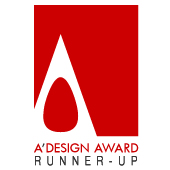 |
Mina Health App by Chunxuan Yu is Runner-up for A' Design Award in Interface, Interaction and User Experience Design Category, 2023 - 2024.· Press Members: Login or Register to request an exclusive interview with Chunxuan Yu. · Click here to register inorder to view the profile and other works by Chunxuan Yu. |
| SOCIAL |
| + Add to Likes / Favorites | Send to My Email | Comment | Testimonials |

